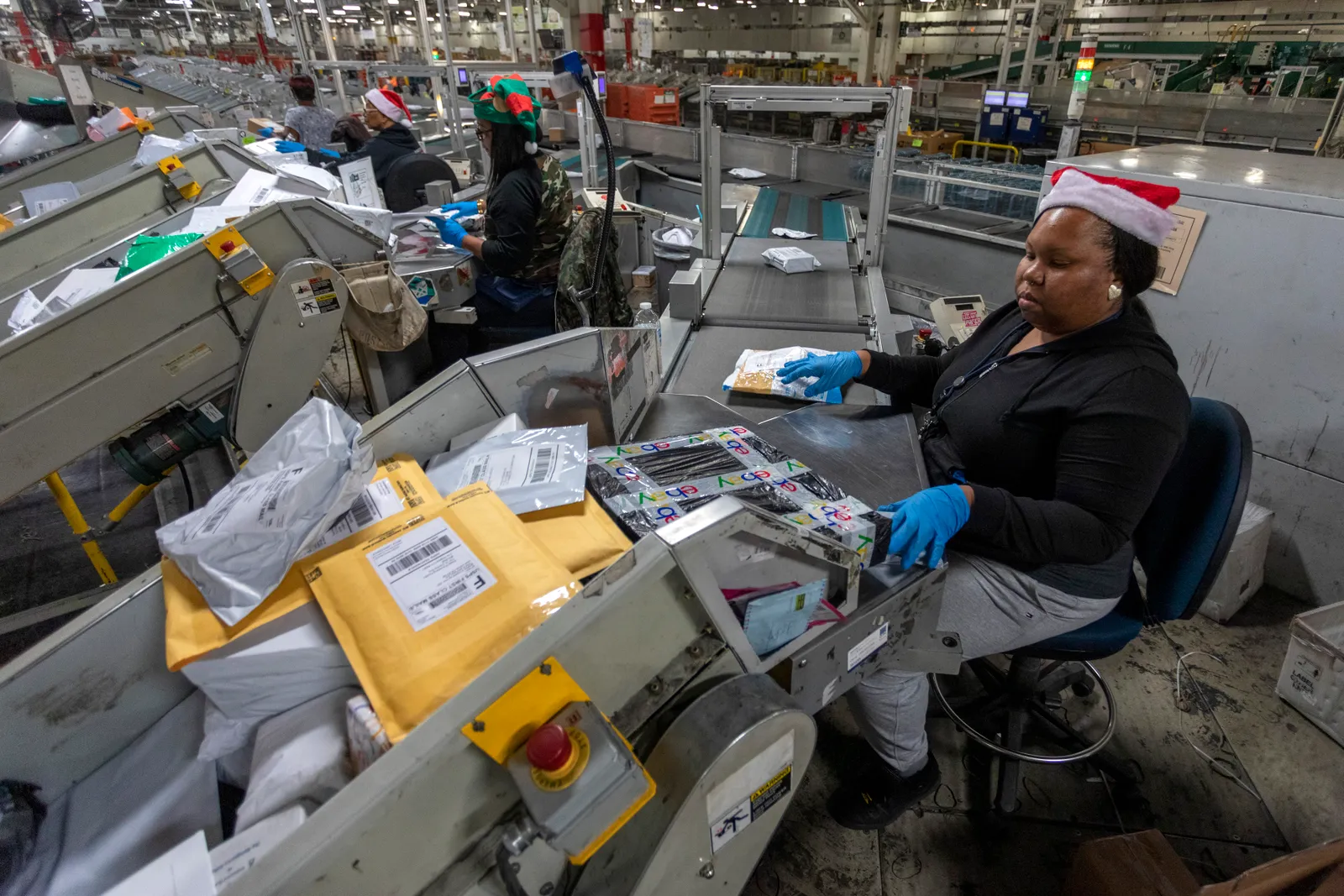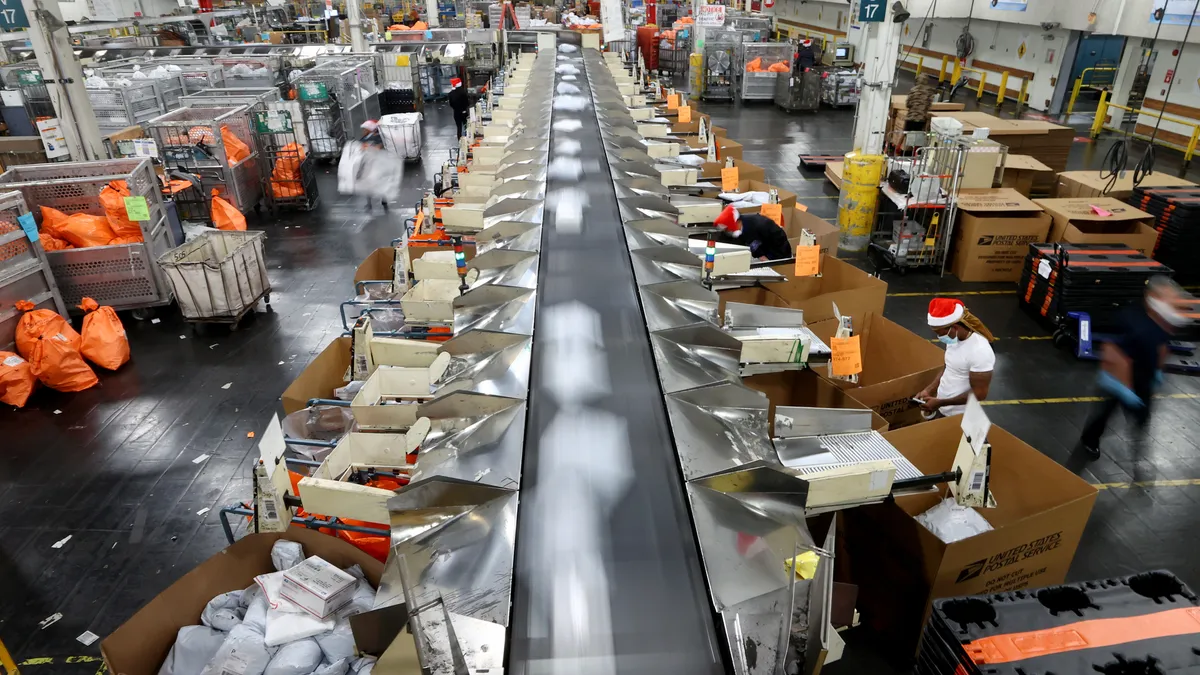In its short life, Pitney Bowes Global Ecommerce carved out a reputation for offering low shipping rates that helped it grow volume even when its future was highly uncertain.
Shein, Victoria's Secret, BarkBox owner Bark and others benefited from the unit’s economical options, which relied on the U.S. Postal Service for last-mile delivery as industry-wide surcharges and rate increases strained shippers' finances.
"Over the last 12 to 24 months, the larger customers that have come over to Pitney Bowes, a lot of them migrated because of price," parcel shipping consultant Mark Waverek said in an interview with Supply Chain Dive.
But offering low prices didn't help Pitney Bowes in its failed effort to make Global Ecommerce, or GEC, a profitable venture. After years of losses, earlier this month, Pitney Bowes sold its majority interest in the unit to Hilco Global, which will liquidate and wind down the business.
The liquidation process is expected to conclude early next year, but GEC delivery services like Domestic Forward Standard Delivery and Domestic Cross-Border U.S. Outbound have already shut down.
Customers will have to shift GEC-destined volume to other shipping providers, if they haven't done so already. Experts told Supply Chain Dive that shippers must consider short-term and long-term factors as they adjust their carrier mixes, ranging from peak season performance to changes within the Postal Service's network.

Multi-carrier strategies will help shippers
The shippers best positioned to avoid any disruptions from GEC’s shuttering are those who already have a flexible multi-carrier strategy in place, experts said. Considering the turmoil that has surrounded GEC in Pitney Bowes' recent quarters, customers should have already been prepping contingency plans prior to the unit's announced closure.
"The shippers that had two or more options set up for every ZIP code where their customers are located, they're feeling good right now," said Timur Eligulashvili, president of Logistics Remix, a parcel delivery carrier representative.
Shippers should evaluate their existing carrier mix first and see which options offer comparable pricing and delivery speeds to GEC before jumping to new providers, experts said. After all, implementing a new carrier can take time, and the clock is ticking as the holiday volume surge approaches.
"You got peak season coming up, you've got a hard shutdown over at Pitney Bowes [GEC], so you've lost a lot of leverage," said Waverek, who is managing partner at PlaidMark Management and Consulting Services. "Unless you have a multi-carrier strategy already in place and Pitney Bowes was just a percentage of your allocated volume, you're in a really bad position."
While the timing of GEC’s shutdown isn't ideal, carriers currently have plenty of space in their networks, especially compared to the capacity-strained stretch between 2020 and 2021 when the COVID-19 pandemic fueled a spike in home delivery. The softer market has led carriers to offer aggressive rate discounts and for pricing power to swing back into shippers' favor.
"The good news is we're still in the shippers' market," Eligulashvili said. "There's slack capacity for delivery, and packages will find their way."
Despite more favorable conditions for shippers, new carriers are unlikely to offer rates as generous to shippers as GEC did, Eligulashvili added.
"It's probably not going to happen, but could they get close to them? And what combination of carriers will offer that? That's the question," he said.

Consolidators offer a straightforward alternative
The simplest option for shippers is to bring GEC volume to other shipping consolidators like DHL eCommerce and OSM Worldwide, according to experts. Like GEC, these companies send parcels to Postal Service facilities for final-mile delivery and offer economical shipping options for lightweight packages.
However, shippers looking at these companies as a long-term alternative should gather information about the impact ongoing changes at the Postal Service will have on service reliability and pricing, Waverek said. The agency recently hiked rates and nixed ounce-based pricing for its Parcel Select service, which consolidators rely on.
That uncertainty may lead shippers to look beyond consolidators for long-term GEC replacements. National parcel carriers such as FedEx and UPS, along with regional alternatives, could be viable options if their pricing is strong enough to sway former GEC shippers, experts told Supply Chain Dive.
Large-scale businesses may also be able to ink a direct contract with the Postal Service and leverage its Ground Advantage delivery offering as the agency looks to attract more direct customers into its network. The Postal Service's mailing options also work for lightweight packages, Gordon Glazer, senior consultant and USPS specialist at Shipware, said in a LinkedIn video.
"There's a 50-to-60% save there," Glazer said. "These packages move just as fast as the ground service, but it does require different tracking symbology as well as specialized packaging in order to conform with the physical requirements of the Postal Service."
Even after shippers shift volume to other providers, the GEC shutdown could present some lingering operational headaches, particularly for package returns.
GEC will pick up returns from the Postal Service until Sept. 5. But if a customer returns a package after that date, where will it end up? Oscar Gladman, senior director of parcel at Kenco Group, said these packages could be held up at a Postal Service facility until a shipper retrieves it themselves.
"It might create an issue for returns customers for a little while who were printing labels and putting them in outbound packages," Gladman said
Editor's note: This story was first published in our Logistics Weekly newsletter. Sign up here.























